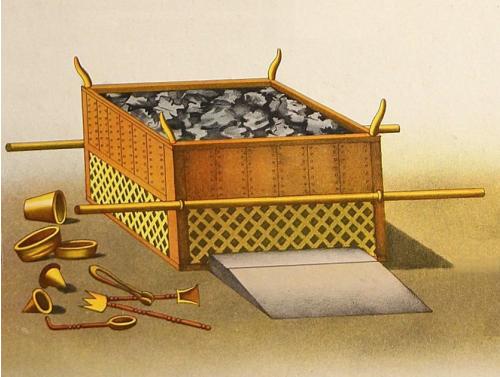
The Bronze Altar Of Sacrifice
The first item in the outer court of the tabernacle was the altar of sacrifice, which was a hollow brass enclosure placed on the ground. the sacrifices had to be placed on the ground inside the altar, for God had said that His altar was always to be one of earth (created by God and not constructed by any man-symbolizing Calvary's cross, and altar made by God himself. (Exodus 20:24-25)
The brass altar was 5 cubits square x 3 cubits high. It was made of shittim wood overlaid with bronze with horns at each corner.
When the common Israelite approached the tabernacle with his sacrifice and passed through that entrance gate he found that between him and the tabernacle structure stood an altar with a priest waiting beside it. The altar was square in shape (foursquare). Its length and breadth were exactly the same as the height of the white linen fence around the court 5 cubits (7 1/2 feet). Its height was 3 cubits (4 1/2 feet) and it was made of acacia wood overlaid with brass with horns at each corner.
Exodus 27:1-2 "And thou shalt make an altar of shittim wood, five cubits long, and five cubits broad; the altar shall be foursquare: and the height thereof shall be three cubits. And thou shalt make the horns of it upon the four corners thereof: his horns shall be of the same: and thou shalt overlay it with brass."
When the brass became hot with the altar-fires, the charring of the wood inside could not be seen on the outside. this symbolizes the inner sufferings of Christ that no one could see.
"Christ therefore having suffered in the flesh, be you also armed with the same thought: for he that hath suffered in the flesh, hath ceased from sins" (I Peter 4:1). Most Christians have seen only the external sufferings of Jesus on the cross. They have no idea about the the inner sufferings that our Lord endured during His earthly life, as He faced different situations and tempted each day.
"For we have not a high priest, who can not have compassion on our infirmities: but one tempted in all things like as we are, without sin." (Hebrews 4:15)
When we draw near to God, we learn more about the inner sufferings that Christ went through. For example, when He was a young boy, people considered Him to be an illegitimate child and must have pointed at Him and said, "His mother is Mary. But we are not sure who His father is." There were many other inner sufferings that He must have gone through during His life. The greatest of all was the break of fellowship with His father on the cross. That suffering was far greater than the nails and the crown of thorns. that suffering was far greater than the nails and the crown of thorns. Most of us don't know the agony of "a break of fellowship" with the father, because we are so used to our fellowship with the father being broken.
Consider this example: People who live in a slum area do not know what perfect hygienic conditions are. but those who have lived in houses where they have never even seen a lizard or a cockroach in their entire lives, will shrink back when they see such things in our houses! It was like that for Jesus. From all eternity He had lived in perfect fellowship with His Father. and then in Gethsemane, He thought of the prospect of being made a sin offering and losing that fellowship when He hung on the cross. He was not afraid of the physical suffering. He would have been willing to go through a hundred physical crucifixions. But when he asked His father "Do I have to drink this cup?"- I propose that the cup he was referring to was not the physical suffering. It was the fellowship with His Father that would be broken on the cross. I think that was what He wanted to avoid at any cost. He prayed and prayed, and the Father told Him, "There is no other way." So our Lord said, "all right, Father, I 'll accept it for the sake of fallen man." there we see the love of Jesus for us-at Gethsemane.
This altar had four horns in the corners to which the sacrificial animals were tied, before they were slain. Psalms 118:27 says, "bind the sacrifice with cords, even unto the horns of the altar." that speaks of the steadfastness, of Jesus in being determined to go to the cross. It says in Luke 9:51, "And it came to pass, when the days of his assumption were accomplishing, that he steadfastly set his face to go to Jerusalem." Nothing would deter Him. We who want to follow Jesus must steadfastly set our face to go that way too.







 Follow
Follow

